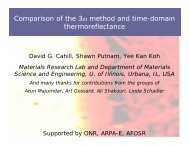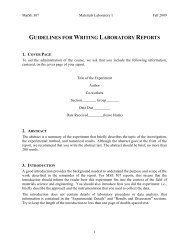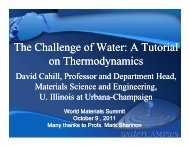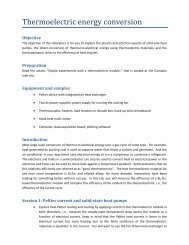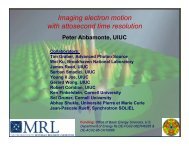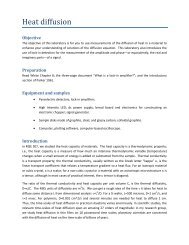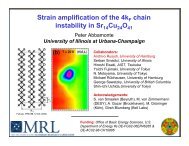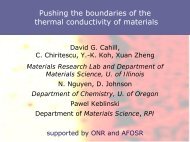Lab C: Pyrometry
Lab C: Pyrometry
Lab C: Pyrometry
- No tags were found...
You also want an ePaper? Increase the reach of your titles
YUMPU automatically turns print PDFs into web optimized ePapers that Google loves.
detector test box has a BaF 2 window that is transparent to visible and IR radiation (up to 17.5 μm) toblock air flow.To collect the data, we use a DS1M12 oscilloscope. Turn on the detector and start the EasyScope IIprogram. You want to trigger ChB with the sync output of the chopper. Adjust the T/Div and V/Divknobs to see a clear image of the signal. Adjust Gnd level if necessary. Pressing Meter A button willdisplay useful readings, which you can customize by pressing configure.FurnaceThe Carbolite MTF 10 furnace is used to heat up the test samples to the desired temperatures. All of thesamples are 3” long rods, and some have hole on one end. To ensure uniform temperature, you want toplace the sample at the center of the heating tube, except when measuring emissivity, see below.Before you start the heating, align the furnace with the lens/chopper/detector. Then, turn on thefurnace with the green switch, press thebutton once so it displays SPoC (sample temperature),press the up and down arrow buttons to select the desired temperature, then press three moretimes to set the temperature. The LCD now displays the current temperature of the heating tube. Tostart the heating, flip the orange switch below the green power switch. The orange light will turn onindicating that the heating coil is on. The temperature will reach the set limit fairly quickly, and overshoot(amount of over‐shoot depends on heating rate) then come down to help the system to stabilize.The sample inside the furnace will take 10 to 15 minutes to stabilize; use the oscilloscope reading as aguide.Note: Cooling the furnace down takes a long time. Using a fan will help, but not by much. Therefore, it isbest to choose appropriate temperature steps and constantly increase the temperature during theexperiment. Also, be gentle when changing temperature, as pushing the buttons too hard might shiftthe furnace and ruin the alignment.Silicon lensThe silicon lens is used to focus IR radiation emitted by the source onto the detector. The lens onlytransmits radiation that has wavelength from 1 to 10 μm, with transmittance T ≥ 70%. It has focal lengthof f = 100mm. You should place the lens in between the furnace and the detector, and the distance toeach is governed by the thin lens equation: f ‐1 = d ‐1 + d’ ‐1 , where d is lens‐to‐furnace distance and d’ islens‐to‐detector distance. The ratio d/d’ is the demagnification of the setup; the larger the number youset, the smaller the image of the source on the detector you get.August 31, 2009



